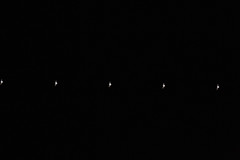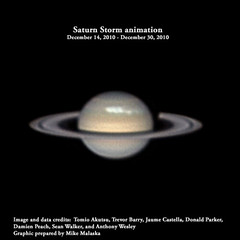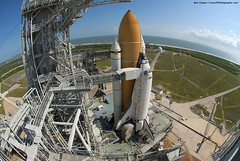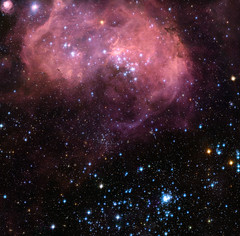
Voyager Space Probe NASA. National Space Centre, Leicester, Leicestershire, UK
latest space news from nasa and internet sources live updates

The Russian Buran space shuttle seems superficially similar to the NASA shuttle but it is really quite different. Buran and the Energia rocket that launches it are quite separate and Buran's engines are not used in the launch. Energia was designed not just to launch the shuttle to Low Earth Orbit, but also to launch heavy payloads to the Moon and beyond so it could easily send Buran to Venus, the closest of all planets to the Earth. The advantages of using a shuttle to enter in Venus’s thick atmosphere are obvious, but Buran wouldn’t survive a landing on Venus’s surface where the temperature is hot enough to melt lead and the pressure is ninety times that of Earth so the shuttle would come to rest high in the atmosphere supported by balloons. Even without the balloons Buran wouldn’t reach the surface but float a few kilometres up in Venus’s thick atmosphere. Getting back to Earth would be impossible without another launcher so before Buran left Earth an empty Energia with a fuel processing unit would be sent to Venus. The Energia would naturally float on Venus and would be supported by a balloon when its tanks were full. Buran would only be launched when the processing was complete. On Venus Buran would rendezvous with Energia and deploy a balloon which would lift the two of them high into the atmosphere ready for launch. While on Venus Buran could release remotely controlled landers to explore the surface and collect geological specimens for return to Earth. The journey from Earth to Venus would take 4 months; Buran would stay 14 months on the Venus, and finally return to Earth two years after its departure. With just two shuttles a mission could be sent at every launch window, enough to maintain a permanent base on Venus with tours of duty of four years, not unlike what was expected of sailors in the great age of sail, or two years if the base was left unmanned between shuttles.

Shots of the ISS. Taken at prime focus of Celestron EdgeHD 925.

339 Space ShipTwo, Virgin Galactic, SBAC Farnborough 2012

La notte in cui Neil Armstrong sognò la luna (my digital creation!)

Compilation of several images taken by multiple observers from December 14, 2010 to December 30, 2010.
Storm observations where the storm was closest to the sub-solar point were selected. The images were then ordered by date and time, reoriented and resized. No contrast or color adjustment was made on the original images.
The storm can be seen to flare up and expand dramatically a few frames in (corresponding to the December 17, 2010 observation). Halfway through the sequence (corresponding to December 25, 2010 observations) the storm develops a bilobed character that becomes increasingly apparent as the sequence continues. North is at top in the sequence.
The bilobed development of the storm is also evidenced by the methane transmission images taken by the Cassini spacecraft in orbit around Saturn: (false color image using MT filters here: www.flickr.com/photos/31678681@N07/5308241667/in/photostr... ) The eastern lobe appears to be the more active one in the Dec 24 Cassini image, as evidenced by the bright upwelling at the core of the E lobe.
Image credits: Tomio Akutsu, Trevor Barry, Jaume Castella, Donald Parker,
Damien Peach, Sean Walker, and Anthony Wesley
Graphic prepared by Mike Malaska

A fisheye view of the Space Shuttle Discovery as it sits on Pad 39A for the final time, in preparation for its last mission STS-133.

33-2-55 ... NOT MY PHOTO. ... Image credit: NASA, ESA and Jesús Maíz Apellániz (Instituto de Astrofísica de Andalucía, Spain)
From www.spacetelescope.org/news/heic1011/?utm_source=feedburn...
Hubble captures bubbles and baby stars
A spectacular new NASA/ESA Hubble Space Telescope image — one of the largest ever released of a star-forming region — highlights N11, part of a complex network of gas clouds and star clusters within our neighbouring galaxy, the Large Magellanic Cloud. This region of energetic star formation is one of the most active in the nearby Universe.
The Large Magellanic Cloud contains many bright bubbles of glowing gas. One of the largest and most spectacular has the name LHA 120-N 11, from its listing in a catalogue compiled by the American astronomer and astronaut Karl Henize in 1956, and is informally known as N11. Close up, the billowing pink clouds of glowing gas make N11 resemble a puffy swirl of fairground candy floss. From further away, its distinctive overall shape led some observers to nickname it the Bean Nebula. The dramatic and colourful features visible in the nebula are the telltale signs of star formation. N11 is a well-studied region that extends over 1000 light-years. It is the second largest star-forming region within the Large Magellanic Cloud and has produced some of the most massive stars known.
It is the process of star formation that gives N11 its distinctive look. Three successive generations of stars, each of which formed further away from the centre of the nebula than the last, have created shells of gas and dust. These shells were blown away from the newborn stars in the turmoil of their energetic birth and early life, creating the ring shapes so prominent in this image.
Beans are not the only terrestrial shapes to be found in this spectacular high resolution image from the NASA/ESA Hubble Space Telescope. In the upper left is the red bloom of nebula LHA 120-N 11A. Its rose-like petals of gas and dust are illuminated from within, thanks to the radiation from the massive hot stars at its centre. N11A is relatively compact and dense and is the site of the most recent burst of star development in the region.
Other star clusters abound in N11, including NGC 1761 at the bottom of the image, which is a group of massive hot young stars busily pouring intense ultraviolet radiation out into space. Although it is much smaller than our own galaxy, the Large Magellanic Cloud is a very vigorous region of star formation. Studying these stellar nurseries helps astronomers understand a lot more about how stars are born and their ultimate development and lifespan.
Both the Large Magellanic Cloud and its small companion, the Small Magellanic Cloud, are easily seen with the unaided eye and have always been familiar to people living in the southern hemisphere. The credit for bringing these galaxies to the attention of Europeans is usually given to Portuguese explorer Fernando de Magellan and his crew, who viewed it on their 1519 sea voyage. However, the Persian astronomer Abd Al-Rahman Al Sufi and the Italian explorer Amerigo Vespucci recorded the Large Magellanic Cloud in 964 and 1503 respectively.
The Hubble Space Telescope is a project of international cooperation between ESA and NASA.